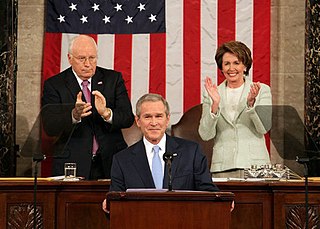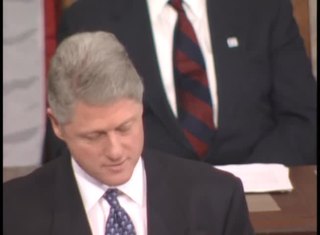Related Research Articles

The State of the Union Address is an annual message delivered by the president of the United States to a joint session of the United States Congress near the beginning of most calendar years on the current condition of the nation. The State of the Union Address generally includes reports on the nation's budget, economy, news, agenda, progress, achievements and the president's priorities and legislative proposals.

The Teller Amendment was an amendment to a joint resolution of the United States Congress, enacted on April 20, 1898, in reply to President William McKinley's War Message. It placed a condition on the United States military's presence in Cuba. According to the clause, the U.S. could not annex Cuba but only leave "control of the island to its people." In short, the U.S. would help Cuba gain independence and then withdraw all its troops from the country.

The 2007 State of the Union Address was given by the 43rd president of the United States, George W. Bush, on January 23, 2007, at 9:00 p.m. EST, in the chamber of the United States House of Representatives to the 110th United States Congress. It was Bush's sixth State of the Union Address and his seventh speech to a joint session of the United States Congress. Presiding over this joint session was the House speaker, Nancy Pelosi, accompanied by Dick Cheney, the vice president, in his capacity as the president of the Senate.

The 2000 State of the Union Address was given by the 42nd president of the United States, Bill Clinton, on January 27, 2000, at 9:00 p.m. EST, in the chamber of the United States House of Representatives to the 106th United States Congress. It was Clinton's seventh and final State of the Union Address and his eighth and final speech to a joint session of the United States Congress. Presiding over this joint session was the House speaker, Dennis Hastert, accompanied by Al Gore, the vice president, in his capacity as the president of the Senate.

The 1995 State of the Union Address was given by the 42nd president of the United States, Bill Clinton, on January 24, 1995, at 9:00 p.m. EST, in the chamber of the United States House of Representatives to the 104th United States Congress. It was Clinton's second State of the Union Address and his third speech to a joint session of the United States Congress. Presiding over this joint session was the House speaker, Newt Gingrich, accompanied by Al Gore, the vice president, in his capacity as the president of the Senate.

The 2014 State of the Union Address was given by the 44th president of the United States, Barack Obama, on January 28, 2014, at 9:00 p.m. EST, in the chamber of the United States House of Representatives to the 113th United States Congress. It was Obama's fifth State of the Union Address and his sixth speech to a joint session of the United States Congress. Presiding over this joint session was the House speaker, John Boehner, accompanied by Joe Biden, the vice president, in his capacity as the president of the Senate.

The 1790 State of the Union Address was the inaugural State of the Union address, delivered by President George Washington to the United States Congress on January 8, 1790, at the Senate Chamber of Federal Hall in New York City.
The 1810 State of the Union Address was given during the first term of President James Madison, the fourth president of the United States. It was given on Wednesday, December 5, 1810 in Washington, D.C. It was "concerning the commercial intercourse between the United States and Great Britain and France and their dependencies having invited in a new form a termination of their edicts against our neutral commerce." It was addressed to the Senate and House of Representatives, it was given right before the War of 1812 began. It was given to the 11th United States Congress, which contains both Houses.
The 1900 State of the Union Address was written by William McKinley, the 25th president of the United States. He began it with these words: "At the outgoing of the old and the incoming of the new century you begin the last session of the Fifty-sixth Congress with evidences on every hand of individual and national prosperity and with proof of the growing strength and increasing power for good of Republican institutions." It was the last of the four addresses given by McKinley. It was given as a written message to the 56th United States Congress. He did not deliver it as a speech.
The 1956 State of the Union Address was delivered by Dwight D. Eisenhower, the 34th president of the United States, on Friday, January 5, 1956, to both houses of the 84th United States Congress in written format. Eisenhower did not deliver a speech before a joint session of Congress because he had suffered a major heart attack four months prior and was recovering in Key West, Florida. Instead, Eisenhower opted to pre-record remarks from his office at the Naval Air Station in Key West summarizing his State of the Union Address which were broadcast to the nation in the evening on January 5.
The 1906 State of the Union Address was written by Theodore Roosevelt, the 26th president of the United States, on Monday, December 3, 1906. He did not speak directly to the 59th United States Congress. He said, "The readiness and efficiency of both the Army and Navy in dealing with the recent sudden crisis in Cuba illustrate afresh their value to the Nation. This readiness and efficiency would have been very much less had it not been for the existence of the General Staff in the Army and the General Board in the Navy; both are essential to the proper development and use of our military forces afloat and ashore."
The 1901 State of the Union Address was given on Tuesday, December 3, 1901, by the 26th president of the United States, Theodore Roosevelt. It was presented to both houses of the 57th United States Congress, but he was not present. He stated, "The Congress assembles this year under the shadow of a great calamity. On the sixth of September, President McKinley was shot by an anarchist while attending the Pan-American Exposition at Buffalo, and died in that city on the fourteenth of that month." He concluded it with, "Indeed, from every quarter of the civilized world we received, at the time of the President's death, assurances of such grief and regard as to touch the hearts of our people. In the midst of our affliction we reverently thank the Almighty that we are at peace with the nations of mankind; and we firmly intend that our policy shall be such as to continue unbroken these international relations of mutual respect and good will."
The 1800 State of the Union Address was given by John Adams, the second president of the United States, on Tuesday, November 11, 1800, to a joint session of the 6th United States Congress. It was the first State of the Union Address delivered at the new United States Capitol in Washington, D.C.
The 1802 State of the Union Address was written by Thomas Jefferson, the third president of the United States, on Wednesday, December 15, 1802. He said, "When we assemble together, fellow citizens, to consider the state of our beloved country, our just attentions are first drawn to those pleasing circumstances which mark the goodness of that Being from whose favor they flow and the large measure of thankfulness we owe for His bounty. Another year has come around, and finds us still blessed with peace and friendship abroad; law, order, and religion at home; good affection and harmony with our Indian neighbors; our burthens lightened, yet our income sufficient for the public wants, and the produce of the year great beyond example."
The 1837 State of the Union Address was given by the eighth president of the United States, Martin Van Buren, on December 5, 1837. It was presented to the 25th United States Congress by a clerk, because it was not yet the custom for the president to deliver it himself. He began with, "We have reason to renew the expression of our devout gratitude to the Giver of All Good for His benign protection. Our country presents on every side the evidences of that continued favor under whose auspices it, has gradually risen from a few feeble and dependent colonies to a prosperous and powerful confederacy."
The 1830 State of the Union Address was given by the seventh United States president, Andrew Jackson on Tuesday, December 6, 1830, to both houses of the United States Congress. He said, "What good man would prefer a toe covered with forests and ranged by a few thousand savages to our extensive Republic, studded with cities, towns, and prosperous farms, embellished with all the improvements which art can devise or industry execute, occupied by more than 12,000,000 happy people, and filled with all the blessings of liberty, civilization, and religion?" He speaks of the Indian Removal Act, "With a full understanding of the subject, the Choctaw and the Chickasaw tribes have with great unanimity determined to avail themselves of the liberal offers presented by the act of Congress, and have agreed to remove beyond the Mississippi River."

The 2015 State of the Union Address was given by the 44th president of the United States, Barack Obama, on January 20, 2015, at 9:00 p.m. EST, in the chamber of the United States House of Representatives to the 114th United States Congress. It was Obama's sixth State of the Union Address and his seventh speech to a joint session of the United States Congress. Presiding over this joint session was the House speaker, John Boehner, accompanied by Joe Biden, the vice president, in his capacity as the president of the Senate.
The 1899 State of the Union Address was a speech given on Monday, December 5, 1899, by President William McKinley, the 25th president of the United States.
The 1902 State of the Union Address was given on Tuesday, December 2, 1902, by the 26th president of the United States, Theodore Roosevelt. It was the second address by Roosevelt.
The 1904 State of the Union Address was submitted on December 6, 1904, by the 26th president of the United States. This was Roosevelt's fourth address.
References
- ↑ "Joint Meetings, Joint Sessions, & Inaugurations | US House of Representatives: History, Art & Archives". history.house.gov. Retrieved 21 October 2024.
- ↑ "Annual Message to Congress (1896)". Teaching American History. Retrieved 2024-12-02.